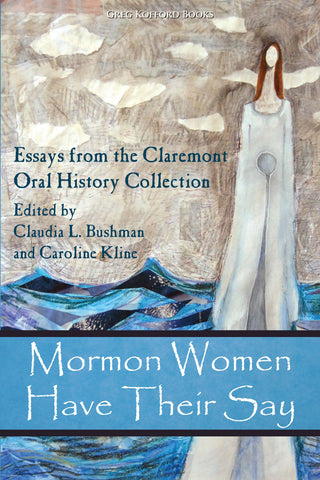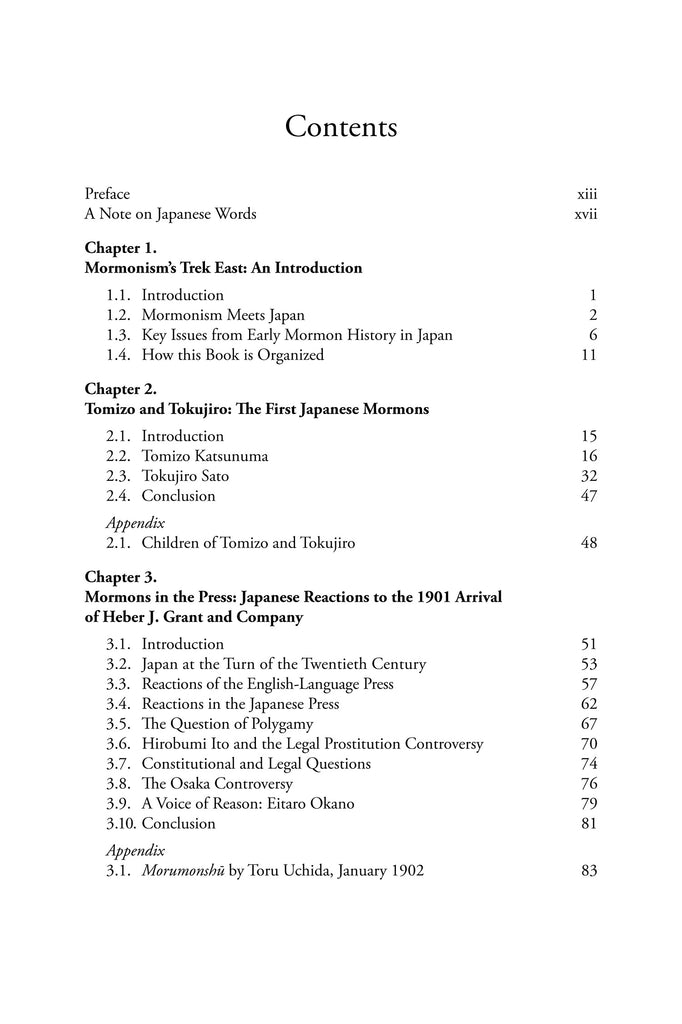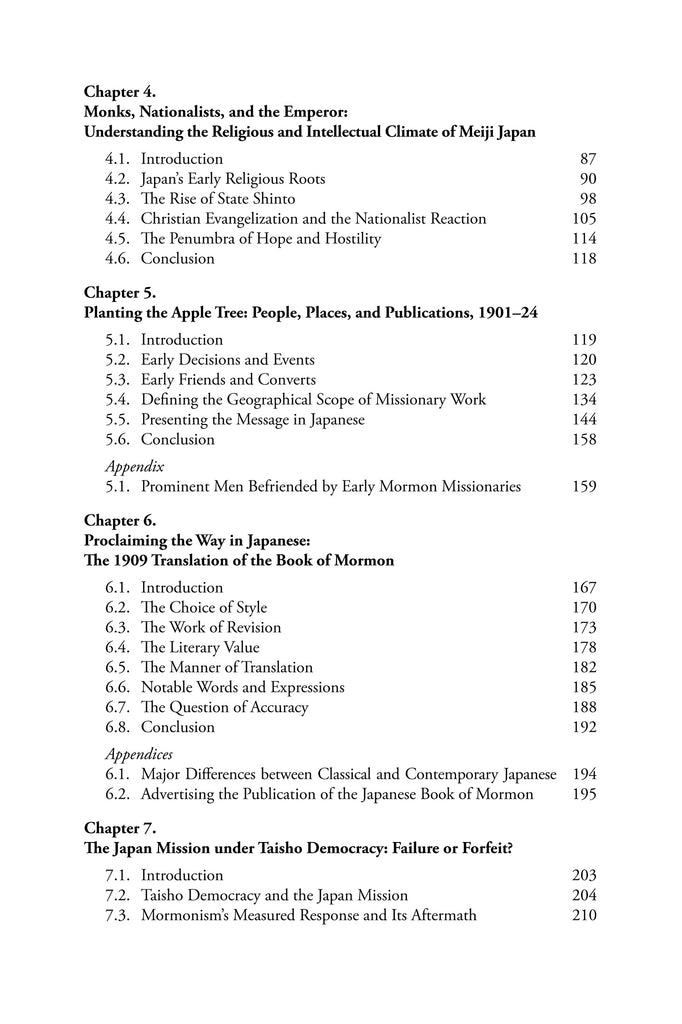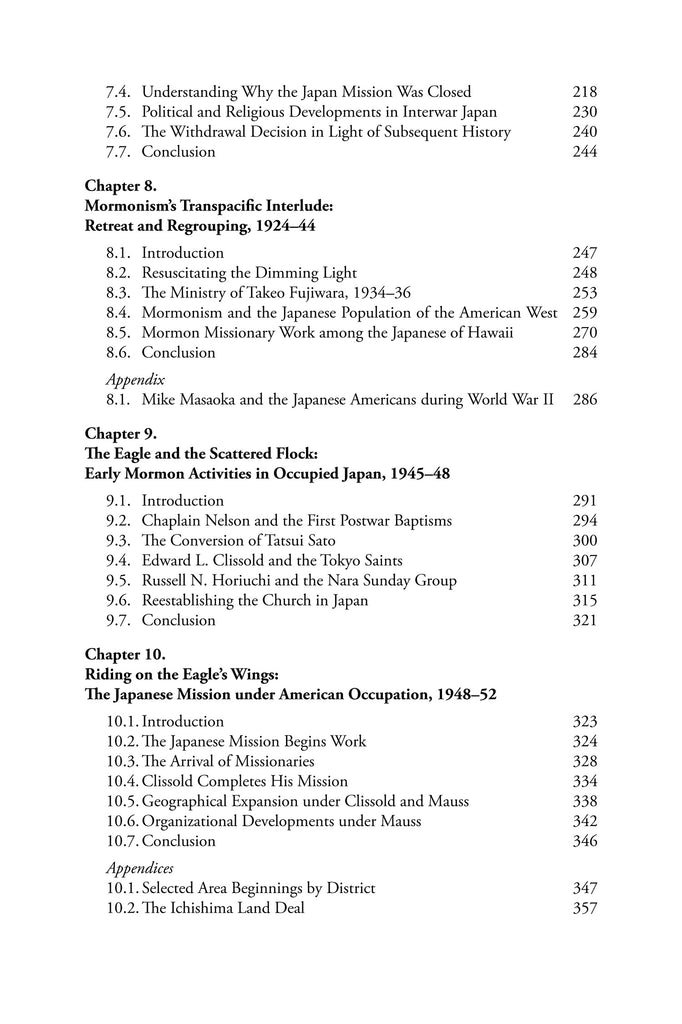The Trek East: Mormonism Meets Japan, 1901–1968
$39.95
日本国内にお住いのお客様は、Amazon.co.jpからご注文ください。
- “A masterful treatment of Mormonism’s foundation in Japan.” — The Millennial Star
- “A terrific, rigorous look into an underserved area of Mormon history.” — By Common Consent
- “This is a wonderful book, full of historical knowledge on a lesser-known subject in LDS history.” — Deseret News
2017 Best International Book Award, Mormon History Association



Available in ebook for your Kindle, Nook, Kobo, Google Play, and Apple.
Also available through Amazon.
Download a free sample preview.
Book Description:
The Trek East represents Mormonism’s ongoing search for a haven in Japan that began at the turn of the twentieth century. This effort to evangelize and grow in Japan occurred with the backdrop of three forces of history that had emerged in the previous century. First, with the aspirations of Manifest Destiny achieved in conquering the western frontier, the United States was becoming a Pacific military and economic power. Second, Japan was opening up its borders after 220 years of national seclusion, allowing its enterprising young men to travel abroad, foreign missionaries to enter the country, and its citizens eventually to practice a religion of their choice. Third, the Church of Jesus Christ of Latter-day Saints, having been freed from government harassment for the practice of polygamy, was beginning to think of going beyond the then established missions.
Author Shinji Takagi takes a distinctively “macro” approach, focusing on the logic behind the narrative—why certain decisions were made and their historical significance. The Trek East is therefore as much about Japan as it is about Mormonism. Readers will observe, through the eyes of Mormonism, the intellectual, legal, political, religious, and social aspects of Japan as the country evolved across history.
Comprehensive Table of Contents:
.
Preface
A Note on Japanese Words
Japan’s Main Islands with Selected Places of Historical Significance
1. Mormonism’s Trek East: An Introduction
1.1. Introduction
1.2. Mormonism Meets Japan
1.3. Key Issues from Early Mormon History in Japan
1.4. How this Book is Organized
2. Tomizo and Tokujiro: The First Japanese Mormons
2.1. Introduction
2.2. Tomizo Katsunuma
2.3. Tokujiro Sato
2.4. Conclusion
Appendix 2.1. Children of Tomizo and Tokujiro
3. Mormons in the Press: Japanese Reactions to the 1901 Arrival of Heber J. Grant and Company
3.1. Introduction
3.2. Japan at the Turn of the Twentieth Century
3.3. Reactions of the English-Language Press
3.4. Reactions in the Japanese Press
3.5. The Question of Polygamy
3.6. Hirobumi Ito and the Legal Prostitution Controversy
3.7. Constitutional and Legal Questions
3.8. The Osaka Controversy
3.9. A Voice of Reason: Eitaro Okano
3.10. Conclusion
Appendix 3.1. Morumonshū by Toru Uchida, January 1902
4. Monks, Nationalists, and the Emperor: Understanding the Religious and Intellectual Climate of Meiji Japan
4.1. Introduction
4.2. Japan’s Early Religious Roots
4.3. The Rise of State Shinto
4.4. Christian Evangelization and the Nationalist Reaction
4.5. The Penumbra of Hope and Hostility
4.6. Conclusion
5. Planting the Apple Tree: People, Places, and Publications, 901–24
5.1. Introduction
5.2. Early Decisions and Events
5.3. Early Friends and Converts
5.4. Defining the Geographical Scope of Missionary Work
5.5. Presenting the Message in Japanese
5.6. Conclusion
Appendix 5.1. Prominent Men Befriended by Early Mormon Missionaries
6. Proclaiming the Way in Japanese: The 1909 Translation of the Book of Mormon
6.1. Introduction
6.2. The Choice of Style
6.3. The Work of Revision
6.4. The Literary Value
6.5. The Manner of Translation
6.6. Notable Words and Expressions
6.7. The Question of Accuracy
6.8. Conclusion
Appendix 6.1. Major Differences between Classical and Contemporary Japanese
Appendix 6.2. Advertising the Publication of the Japanese Book of Mormon
7. The Japan Mission under Taisho Democracy: Failure or Forfeit?
7.1. Introduction
7.2. Taisho Democracy and the Japan Mission
7.3. Mormonism’s Measured Response and Its Aftermath
7.4. Understanding Why the Japan Mission Was Closed
7.5. Political and Religious Developments in Interwar Japan
7.6. The Withdrawal Decision in Light of Subsequent History
7.7. Conclusion
8. Mormonism’s Transpacific Interlude: Retreat and Regrouping, 1924–44
8.1. Introduction
8.2. Resuscitating the Dimming Light
8.3. The Ministry of Takeo Fujiwara, 1934–36
8.4. Mormonism and the Japanese Population of the American West
8.5. Mormon Missionary Work among the Japanese of Hawaii
8.6. Conclusion
Appendix 8.1. Mike Masaoka and the Japanese Americans During World War II
9. The Eagle and the Scattered Flock: Early Mormon Activities in Occupied Japan, 1945–48
9.1. Introduction
9.2. Chaplain Nelson and the First Postwar Baptisms
9.3. The Conversion of Tatsui Sato
9.4. Edward L. Clissold and the Tokyo Saints
9.5. Russell N. Horiuchi and the Nara Sunday Group
9.6. Reestablishing the Church in Japan
9.7. Conclusion
10. Riding on the Eagle’s Wings: The Japanese Mission under American Occupation, 1948–52
10.1. Introduction
10.2. The Japanese Mission Begins Work
10.3. The Arrival of Missionaries
10.4. Clissold Completes His Mission
10.5. Geographical Expansion under Clissold and Mauss
10.6. Organizational Developments under Mauss
10.7. Conclusion
Appendix 10.1. Selected Area Beginnings by District
Appendix 10.2. The Ichishima Land Deal
11. Enlarging the Borders: Modern Ecclesiastical Developments, 1952–68
11.1. Introduction
11.2. The Evolving Scope of Missionary Work
11.3. The Opening of Work in Okinawa and Korea
11.4. Securing Places of Worship
11.5. Developing Local Leadership
11.6. Conclusion
12. Leafs, Steeples, and Testimonies: Building the Foundation for Future Growth, 1948–68
12.1. Introduction
12.2. The Translation of LDS Scriptures
12.3. Assessing the Quality of the 1957 Translation
12.4. Revamping the Approach to Missionary Work
12.5. The Building Program
12.6. Building the Testimonies of Japanese Mormons
12.7. Understanding the Postwar Growth of the LDS Church in Japan
12.8. Conclusion
Annex 1. The Iwakura Mission in Salt Lake City
Annex 2. George Jarvis: Was He the First Mormon Missionary to Japan?
Annex 3. The Rise and Fall of Walter Murray Gibson
Annex 4. Notable Japanese Mormons from the Prewar Period
1. Takeo Fujiwara (1906–36)
2. Tsuruichi Katsura (1891–1982)
3. Tamano Kumagai (1892–1978)
4. Chojiro Kuriyama (1896–1971)
5. Ei Nachie (1892–1982)
6. Tsune Nachie (1856–1938)
7. Fujiya Nara (1898–1992)
8. Nami Suzuki (1881–1974)
9. Tomigoro Takagi (1894–1973)
10. Yoshijiro Watanabe (1873–circa 1940)
Annex 5. Mormon Mission Presidents, 1901–68
Annex 6. Selected Major Newspapers in Japan that Published Articles, Editorials, and Letters on Mormonism Between August and September 1901
A6.1. By Date
A6.2. By City and Date
Annex 7. Mormon Missionaries in the Japan Mission, 1901–24
Annex 8. Converts and Children of Record Baptized in Prewar Japan, 1902–39
Annex 9. Mormon Converts Baptized in Occupied Japan, 1946–521
Annex 10. Mormon Missionaries in the Japanese and Northern Far East Missions, 1948–68
Annex 11. Early American Labor Missionaries in Japan, 1962–69
Northern Far East Building Committee
Building Supervisors
Annex 12. Partial List of Locally Called Labor Missionaries in the Northern Far East Mission, 1962–68
Glossary of Mormon and Japanese Terms
Bibliography
Abbreviations:
Book Chapters:
Articles in LDS Church Periodicals:
Articles in Other Periodicals:
Theses and Dissertations:
Journals and Personal/Family Histories
Unpublished or Internet Sources:
Others (in author’s possession):
Correspondence:
Personal Interviews:
Archived Materials:
Periodicals, with their Depositories
Subject Index
Name Index
Q&A with the Author:
.
Q. Can you give us a brief background on yourself, both academically and professionally, and what led to your interest in researching this topic?
A. I am an economist by profession. I have been an academic for about 20 years of my professional career and an international civil servant for about 15 years. As an academic, I have also held appointments with Japanese government agencies and consulted for several international organizations. My specialty is international monetary economics. My professional work has involved a number of developed, emerging, and developing economies across the world. At present, I am engaged in work on low-income country cases.
My book discusses the encounter of Mormonism with Japan. Perhaps I should explain how I first encountered America some 45 years ago as a way of introducing my background. When I was growing up in Japan as a child, I had no idea that I would be spending nearly half of my adult life in the United States. Rather accidentally, I received a scholarship to study at an American college toward the end of my senior year in high school. The sponsor was an educational fund called the Grew Foundation, established in 1950 with support from Japan’s leading political and business leaders. It bears the name of a former American ambassador to Japan, Joseph C. Grew, who contributed seed money to the fund. The foundation’s aim was to provide opportunities for American-style liberal arts education to Japanese students who might then become instrumental in rebuilding Japanese–American relations in the postwar era. I would like to think I have made some progress toward this aim by writing this book.
I explain in the preface of the book how I became interested in Japanese Mormon history almost by chance—I was asked to translate an English text on the subject. It was the scholar in me (“curiosity and preoccupation with accuracy”) that kept my interest alive thereafter. It has taken me nearly 25 years of part-time, intermittent work to complete the book! Looking back, I feel I was compelled to write this book.
Q. For readers who are not familiar with the history of LDS missionary work in Japan, can you give us a short summary of activity?
A. Japan was one of the first non-Christian nations to receive Mormon missionaries. LDS missionary work began in 1901 and continued until 1924. Missionaries returned to Japan in 1948, three years after the end of World War II. My book covers not only the periods of Mormon missionary activity in Japan, from 1901 to 1924 and from 1948 to 1968, but also the period when the Church was absent. LDS missionary work is still ongoing, but the book’s coverage ends in 1968 when the mission in Japan was divided into two entities.
Q. What sets The Trek East apart from other books and articles written on the topic of LDS missionary work in Japan?
A. Two things set this book apart from others. First, I do not rely solely on English-language sources. Second, I try to interpret the historical contexts of major events and decisions. These two things, of course, are not independent. Interpretation of historical contexts would be impossible if you were relying on English sources alone. In making these remarks, I am not taking anything away from previous authors. It is their writings that have allowed me to go further.
Q. Early LDS missionary work in Japan is often considered a failure. What do you think contributes to this perspective?
A. A mass conversion of the type experienced, for example, in the British Isles never happened in Japan. That this did not happen may have been a disappointment to some Church leaders, who had hoped that the blood of Israel should make the Japanese people receptive to the Mormon message. Whatever the reason, the Church subsequently did not devote the resources necessary to make a viable presence. The average number of missionaries serving at any one time was about 13 for a country half the population of the United States. I give the subtitle “failure or forfeit?” to the chapter where I discuss these issues. Did the work inherently fail or did it only appear to fail because the Church did not make enough effort? I don’t pretend to give a definitive answer.
Q. Some observers have blamed the disintegration of U.S. and Japan relations for the perceived failure in early LDS missionary work in Japan. What are your thoughts on this?
A. Political events, including international relations, clearly impacted the Mormon experience in the period preceding World War II. I devote a considerable part of the book to discussing how Japanese–American relations may have influenced the Church’s decision to close the mission in 1924. An important point I make is that those who have related the mission’s closing to international politics made their remarks from the vantage point of the postwar era, when the war and the events in Japan that had led up to it were a fait accompli. The war became the convenient explanation for an uncomfortable event in the history of the Church.
Q. What does the history of LDS missionary work in Japan teach us about international missionary work in general?
A. Writing this book has not qualified me to answer this question, except to say that the productivity of LDS missionary work appears to depend on the evolving religious and intellectual climate of a society. The window of opportunity, when there is a radical societal change, is typically short. To take advantage, the Church needs to devote a critical mass of resources quickly. The LDS Church is much better placed to do so today, given the resources now available, than it was in Japan, for example, during the immediate postwar period.
Praise for The Trek East:
“Both this book and its author are unique in contemporary scholarship. The book is the first scholarly (as contrasted with hagiographic) study of the challenges faced by the Mormons in their effort to establish a new form of Christianity in a country already undergoing drastic political, economic, and religious transformations. As a distinguished Japanese social scientist, and an adherent himself of the Mormon religion, the author is well positioned to interpret both the Japanese and the religious aspects of this encounter to the reader.” — Armand L. Mauss, author of The Angel and the Beehive: The Mormon Struggle with Assimilation and All Abraham’s Children: Changing Mormon Conceptions of Race and Lineage
“In The Trek East, Dr. Shinji Takagi has produced a masterful treatment of Mormonism’s foundation in Japan. Dr. Takagi takes an approach that informs us of Mormonism in Japan in a manner that focuses on inputs and results, environmental conditions in Japan and cultural biases of a Mormonism informed by western assumptions.”
— Meg Stout, The Millennial Star
“[Shinji] Takagi, a professor of Economics who has published extensively in multiple countries, refers consistently to newspapers, journals, diaries and other primary sources. His work is both detached and intimate: Takagi describes not only the key dates and places, he deals with the family stories and histories of the early Saints in Japan, luminaries such as Takeo Fujiwara and Tatsui Sato whose influence over the Japanese Church are still felt today. . . . The Trek East is a terrific, rigorous look into an underserved area of Mormon history.”
— Steve Evans, By Common Consent
“This is a wonderful book, full of historical knowledge on a lesser-known subject in LDS history. The author, who is Japanese, LDS and lives in Virginia, is deeply invested in the subject and carefully includes all sides of the history.”
— Mike Whitmer, Deseret News
“Shinji Takagi, Professor Emeritus of Economics at Osaka University, presents an ambitious work that focuses on a “macro” and “analytical” approach to Mormonism’s historical presence in Japan from 1901 to 1968.”
— Jeff T., Juvenile Instructor
“[Shinji] Takagi is to be commended for embracing the vital undertaking of telling a story about Japanese Mormonism that captures the richness and complexity of its local context.”
— Emily Anderson, Mormon Studies Review, Vol. 5
“A monumental work of scholarship. . . . I can't imagine that any future study of this period could hope to provide a more thorough and engrossing analytical study of the origins and growth of the Church in Japan. This remarkable contribution is unlikely ever to be supplanted.”
— Van C. Gessel, Journal of Mormon History, Vol. 44, No. 2
“Shinji Takagi’s extremely detailed and thoroughly researched book The Trek East makes a significant contribution to understanding early LDS Church history in Japan. Although the book covers a period that has been extensively described in previous scholarship, Takagi does not present another historical narrative of key events but rather provides a rigorous study of the social influences that impacted those events. This analytical approach brings a layer of explanatory depth that has, until now, been absent in studies of Church history in Japan. The result is a product rich in insight into the ways religious, economic, and political environments in Japan shaped the unfolding story of the LDS Church in that country.”
— Stephen J. Moody, BYU Studies Quarterly, Vol. 57, No. 2
About the Author:
 Shinji Takagi is Professor Emeritus of Economics at Osaka University. The author of nearly 200 publications, Professor Takagi has also held senior positions at the International Monetary Fund and visiting professorships at Brigham Young and Yale Universities. He is a graduate of Swarthmore College and obtained his Ph.D. in economics from the University of Rochester. He currently lives, with his wife, in the Washington D.C. suburb of Arlington, Virginia.
Shinji Takagi is Professor Emeritus of Economics at Osaka University. The author of nearly 200 publications, Professor Takagi has also held senior positions at the International Monetary Fund and visiting professorships at Brigham Young and Yale Universities. He is a graduate of Swarthmore College and obtained his Ph.D. in economics from the University of Rochester. He currently lives, with his wife, in the Washington D.C. suburb of Arlington, Virginia.
More Information:
596 pages
ISBN: 978-1-58958-560-7 (paperback); 978-1-58958-561-4 (hardcover)
Published September 2016















Share this item: